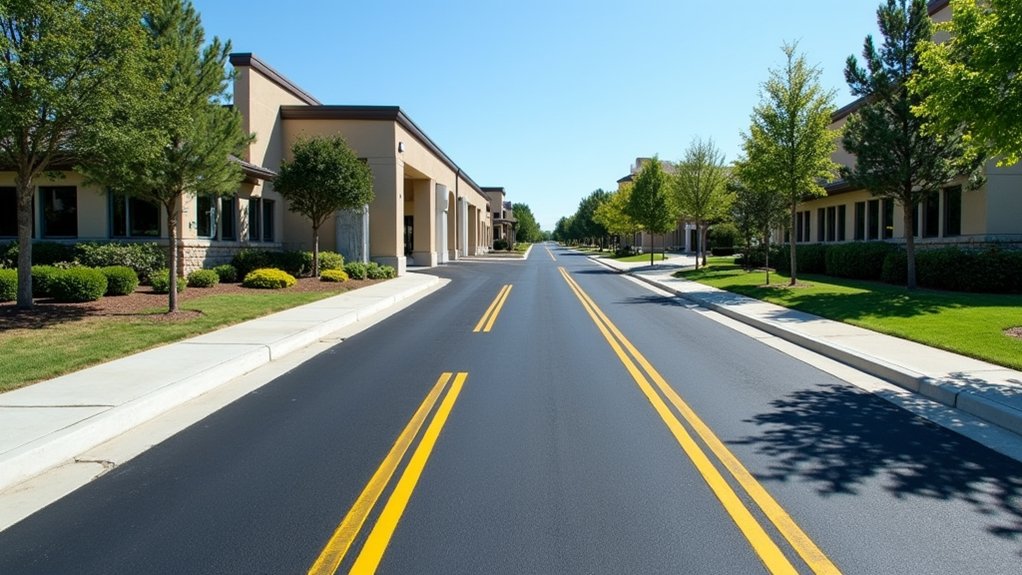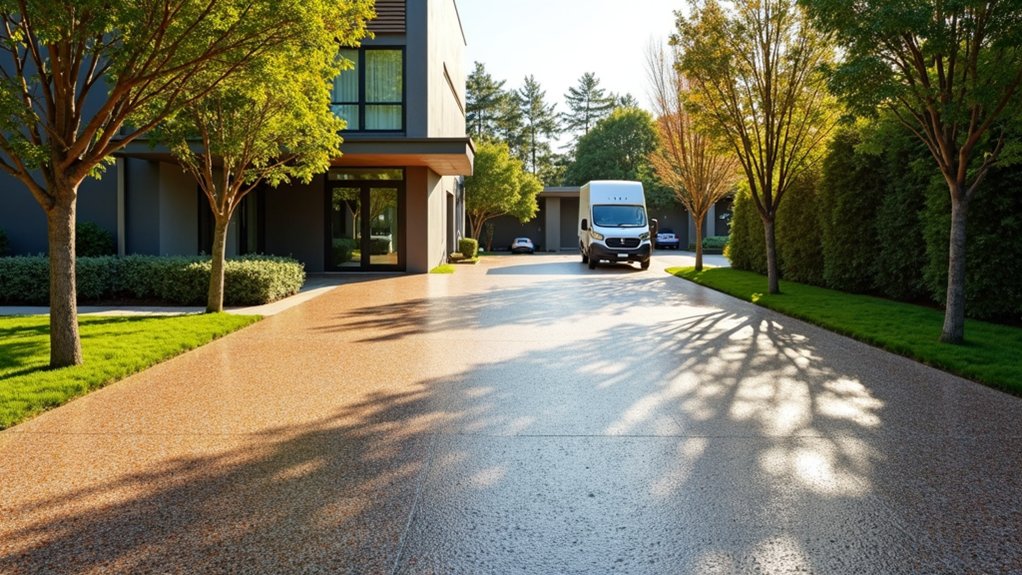To design a commercial driveway for heavy traffic, ensure your widths comply with regulations—6.7 metres for two-way traffic and 4.9 metres for one-way access. Make sure to include adequate turning radii for larger vehicles, ideally between 30 to 50 feet. Limit access points to reduce conflict and congestion. Incorporate safety features such as clear signage and traffic calming measures. Be mindful of environmental compliance and local regulations. Interested in more tips for improving your driveway design?
Table of Contents
ToggleKey Takeaways
- Ensure driveway widths are at least 6.7 metres for two-way access to accommodate heavy traffic and larger vehicles effectively.
- Design turning radii of at least 4.5 metres to allow for safe manoeuvring of larger vehicles and reduce the risk of accidents.
- Limit the number of access points to reduce conflict and congestion, in line with local access management regulations.
- Implement a maximum slope of 7% to 9%, ensuring smooth transitions with a minimum gradient length of 3 metres.
- Use sustainable materials and carry out traffic impact assessments to meet environmental regulations and improve safety.
Understanding Traffic Volume and Driveway Width Requirements
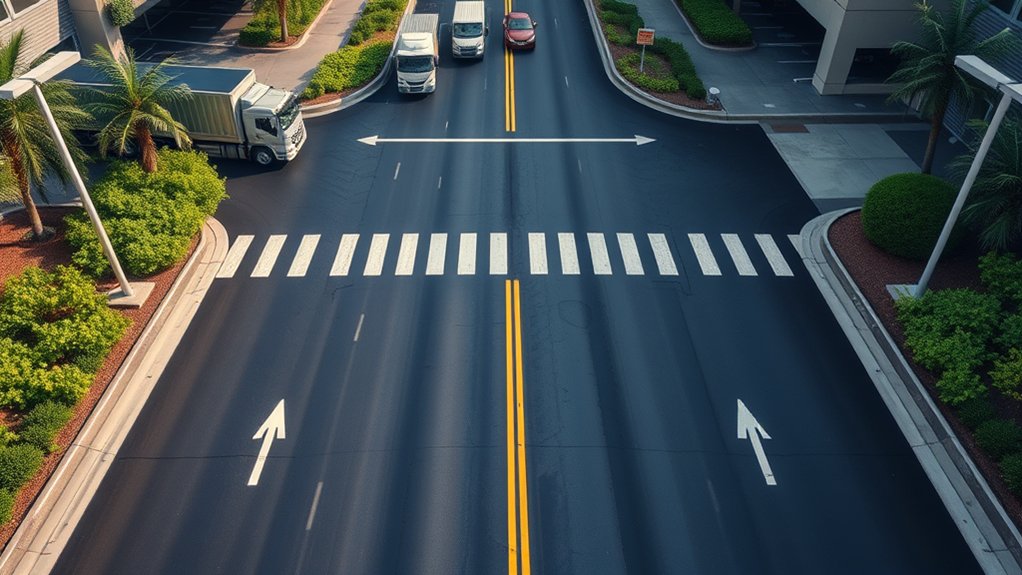
When designing a commercial driveway, it’s crucial to understand traffic volume, as this impacts the required width and strength of the driveway. High traffic levels typically call for wider driveways—at least 6.7 metres for two-way access and 4.9 metres for one-way access.
For driveways accommodating two cars, widths of 5.5 to 6.1 metres are advisable for safe parking and manoeuvring.
Consider the size and weight of vehicles, particularly larger ones like lorries and motorhomes, which need more space and stronger materials to support their weight. Adhering to local regulations is vital to ensure smooth traffic flow and avoid congestion during busy periods, making width requirements a key aspect of effective commercial driveway design. Compliance with off-street parking standards ensures that the driveway is designed to meet necessary safety and operational guidelines.
Importance of Turning Radius and Grade Considerations
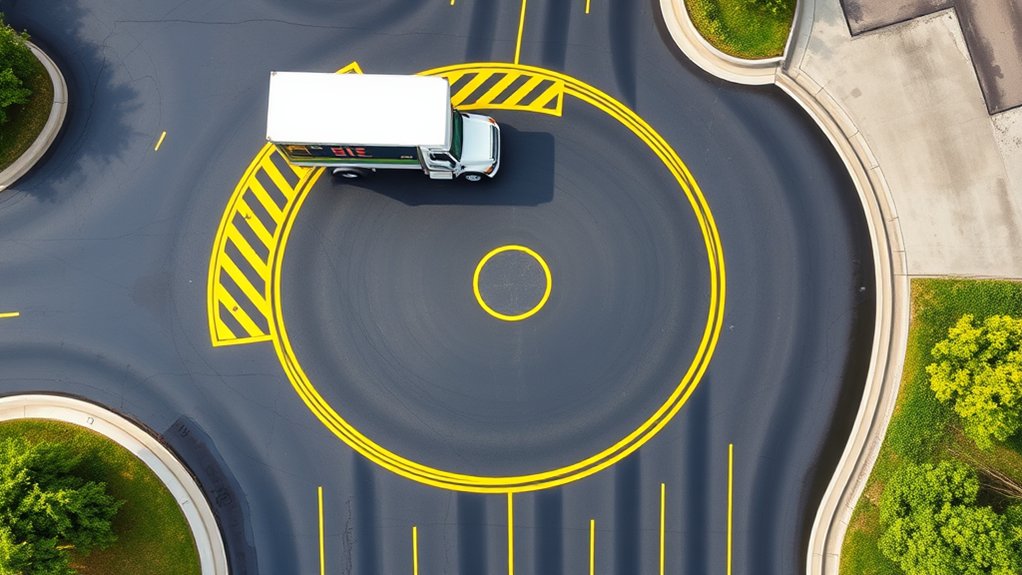
When designing a commercial driveway, it’s crucial to consider the turning radius and gradient to safely accommodate heavy traffic. The minimum turning radius should be large enough for the biggest vehicles, like lorries, which can range from 30 to 50 feet. A tight turning radius can lead to vehicles encroaching on other areas, increasing the risk of accidents. Additionally, unsupported browsers may lead to a degraded user experience, which could affect how drivers navigate the driveway.
Gradient is equally important; maximum slopes shouldn’t exceed 7% to 9% to ensure safe vehicle movement and effective drainage. Any sudden changes in gradient should have a minimum length of 10 feet to facilitate smooth transitions.
Implementing Effective Access Management Strategies

Implementing effective access management strategies is vital for enhancing safety and traffic flow in commercial driveways. By minimising conflict points through limited driveways and median openings, you reduce the risk of accidents and improve efficiency. Fewer access points lead to less congestion and greater safety. It’s crucial to regulate access rights through local and state agencies to ensure controlled access along major roads, which promotes safe traffic movement. Proper spacing of driveways is equally important, as it helps manage the number of entry and exit points, reducing congestion. Furthermore, access management ordinances enforce design standards that match roadway classifications, effectively balancing traffic mobility and accessibility to support community development. Effective access management can also lead to increased capacity and reduced crashes, which is essential for communities experiencing growth.
Safety Features to Incorporate for Heavy Traffic
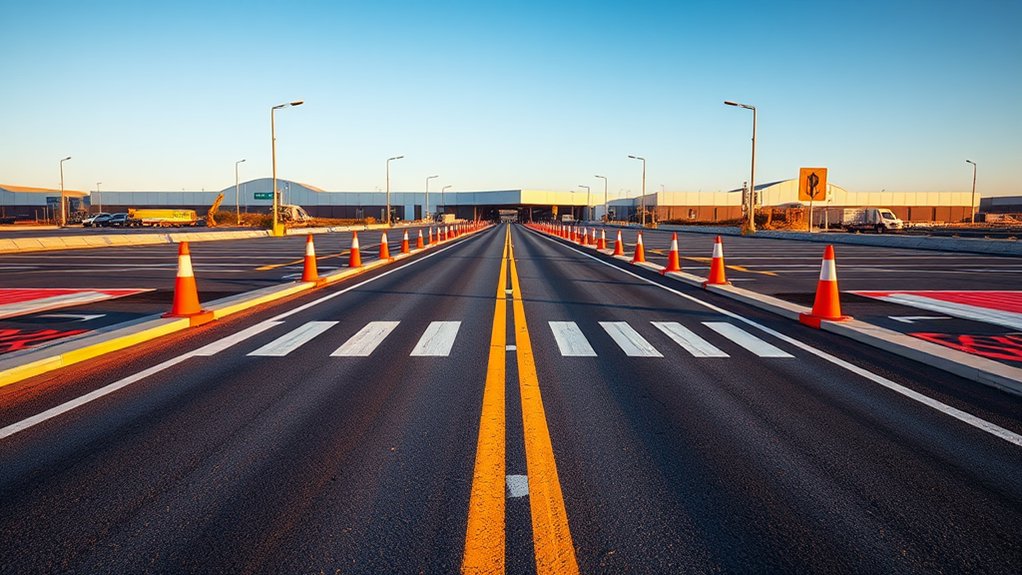
To improve safety in commercial driveways with heavy traffic, it’s essential to incorporate several key features.
Start by consolidating entrances to minimise conflict points, ensuring a smoother flow of vehicles. Use proper turning radii of at least 15 feet and consider traffic calming measures such as speed bumps and raised pedestrian crossings to encourage slower driving.
Clear safety signage is crucial; utilise reflective markers to define edges and warn drivers of potential hazards.
Additionally, modifying lanes and narrowing driveways can help manage speed differences and reduce the risk of accidents.
Regular inspections and maintenance of these features will ensure compliance with safety standards, making the driveway safer for both vehicles and pedestrians.
Environmental and Regulatory Compliance in Driveway Design
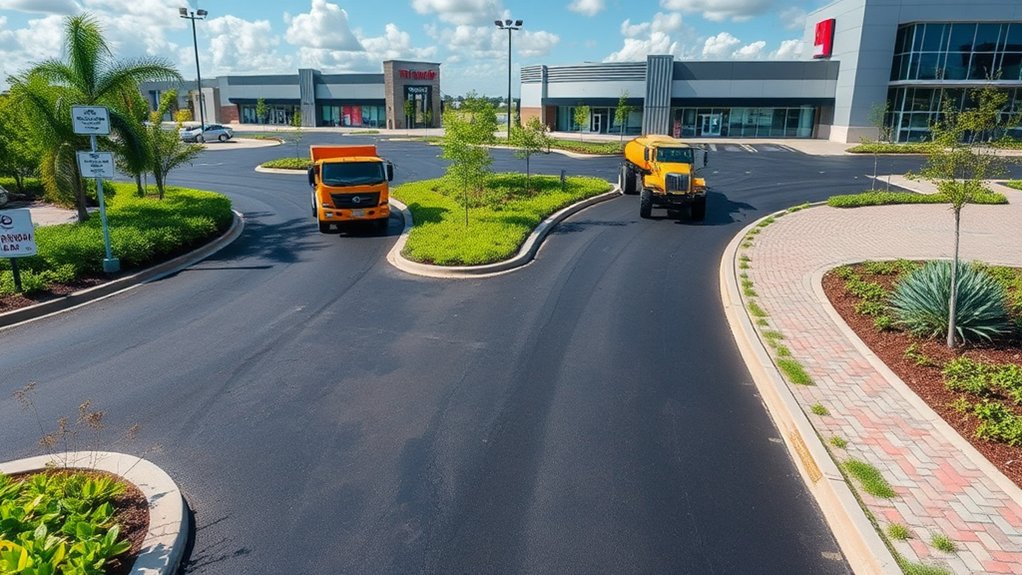
Designing a commercial driveway in the UK requires careful consideration of environmental and regulatory standards, which are crucial for safety and functionality.
Use sustainable materials, such as recycled asphalt, to reduce resource use and support environmental efforts. Be aware of local regulations, including access management codes and planning permissions, as these dictate how driveways should be designed and positioned to ensure safe and efficient traffic flow.
It’s important to conduct traffic impact assessments to understand the potential environmental effects and to implement effective drainage solutions to prevent water pollution. Additionally, comply with noise pollution regulations and local guidelines on width and access. By following these practices, you can create a driveway that meets regulatory requirements and contributes to sustainability. Furthermore, consider the long-term durability of your materials, as this can significantly influence maintenance needs and environmental impact.
Frequently Asked Questions
What Are the Best Materials for Heavy Traffic Driveways?
For heavy traffic driveways, you might want to consider reinforced concrete for its strength or durable asphalt for its flexibility. Both materials perform well, but it’s important to assess initial costs against long-term maintenance. For example, concrete can be more expensive upfront but often requires less upkeep, while asphalt may need periodic resurfacing. Choose the option that best fits your budget and maintenance preferences.
How Can Landscaping Enhance Driveway Functionality?
Landscaping improves driveway functionality by incorporating proper drainage solutions that help prevent flooding and enhance visual appeal. By using thoughtful planting and suitable materials, you can ensure effective water management while creating an inviting atmosphere for users. For instance, adding permeable paving or strategically placed plants can allow rainwater to drain efficiently, reducing puddles and making the space more accessible.
What Are Common Mistakes in Driveway Design?
When designing driveways, it’s essential to steer clear of common pitfalls such as poor slope and drainage problems. For instance, if a driveway is too flat, water may pool, causing damage and creating safety hazards. Proper planning is crucial for effective water management, helping to avoid costly repairs down the line.
How Do Weather Conditions Affect Driveway Design?
Weather conditions have a significant impact on driveway design in the UK. For instance, snow and ice can cause accumulation, while temperature swings may lead to cracks and structural damage. It’s essential to select materials that can withstand these elements, such as durable concrete or permeable paving. Effective drainage solutions are also crucial to prevent water pooling and subsequent freeze-thaw cycles that could compromise the driveway’s integrity. By considering these factors, you can ensure your driveway stands the test of time.
What Permits Are Needed for Driveway Construction?
You’ll need to obtain construction permits that comply with local zoning regulations. Ensure your driveway design adheres to council ordinances, taking into account any environmental concerns, utility lines, and safety standards to prevent issues during the approval process. For instance, if you’re planning a new driveway, check if you need planning permission, especially if it involves altering a dropped kerb.
Conclusion
When designing a commercial driveway for heavy traffic, focus on traffic volume, width, and turning radii while prioritising safety and compliance. Think of it like creating a major road entrance; every detail is crucial. Effective access management strategies can streamline traffic flow and improve safety. Additionally, by adhering to environmental regulations, you’ll not only meet legal requirements but also promote sustainable practices. With these considerations, your driveway will be built to endure.
Professional-grade resin-bound driveways offer durability and customization, but are they truly the best investment for your business? Discover the potential Read more
Achieving effective commercial driveway drainage requires understanding regulations and best practices that ensure safety, efficiency, and compliance—learn how to optimize Read more
When selecting a contractor for your commercial driveway, discover the key factors that ensure your project's success and avoid costly Read more

